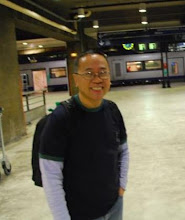 |
| Museum of Philippine Art and Culture, San Fernando |
An
invitation from
Mrs. ANDREA DIZON DOMINGO to the launch of her foundation’s
MUSEUM OF PHILIPINE ARTS AND CULTURE, was an event certainly not to be missed
by the staff of the Center for Kapampangan Studies, and that included me. Though
many remember her of late, as the Chairman and CEO of PAGCOR (Philippine
Amusement and Gaming Corporation), she was also at some point, a commissioner of
the Bureau of Immigration and a Pampanga congresswoman.
 |
| A cabinet-ful of antique santos |
But I
remember Mrs. Domingo as an owner of a well-know antique shop in
Intramuros—GALERIA ANDREA—and who later put up a swanky branch at the LRI
Plaza in Makati. I was a habitue of her antique shop that was always full to
the rafters with antique santos, exquisite colonial jewelry, paintings, blue
and white jars, and pottery diggings—all tastefully displayed under glass or organized
on shelves and walls.
 |
| Ivory Sto. Nino flanked by San Jose and Sta. Maria |
I only
have one santo purchase to show after all my frequent visits to her shops— an armless
Santo Niño with a bone face on a globe base. I was content with browsing at her
shops as she had probably one of the most select antique pieces in Intramuros.
So, when I learned that she was opening a museum, I had no doubt that it will
be nothing less than the best—I had already in my mind the quality and
diversity of pieces she will be showcasing.
 |
| An ivory Calvario scene. |
I had expected
a small museum in a San Fernando subdivision, but I was floored when I saw it
was in a huge 2-story building with expansive spaces. She explained that the building
was a re-purposed ballroom dance hall that she had built at a time when she
took up the hobby, and wanted a venue for other dance enthusiasts.
 |
| A folk Virgen and Sto. Nino in a box urna |
Entering
the well-lit, cavernous hall were walls and walls of paintings from past and
present masters, presidential merit winners, Mabini painters, and National Artists, a virtual who’s who in
Philippine art history. Outside of Manila, this museum has perhaps the largest
assemblage of paintings done by National Artists—works of Amorsolo, Ang Kiukok,
Botong Francisco, hang side by side with the paintings of Magsaysay-Ho, Edades, Joya, and Legaspi.
 |
| A cabinetful of antique santos |
In another
wing, the rooms displayed pre-colonial artifacts like bul-ols, oriental trade
jars, potteries from various diggings, tribal art and textiles.
 |
| More santos on display. |
But of
course, the one room that piqued my interest most was the santo collection in a
wing of its own. The most precious ones—including the valuable ivories, were shown
in well-lit floor to ceiling glass cabinets. The amazing exhibit featured
mostly folk santos, many left overs from her antique shops, but still of
impeccable quality no less. The antique santo collection is featured in these
photos.
 |
| L-R: Ivory San Juan Bautista, and a pair of wooden San Roques |
The MUSEUM
OF PHILIPPINE ART AND CULTURE is set to open fully in July. It is located along
the highway of San Fernando, brgy. San Agustin, next to Ramar Village, and across
St. Scholastica Academy.
 |
| A gathering of Virgins and Sto. Ninos |
 |
| A Sto. Nino among Virgenes |
 |
| Ivory santos of the most precious variety |
 |
| More ivories for the eyes to feast on. |
 |
| The Ivory Section of the exhibit |
 |
| Folk antiquities |
 |
| Of wood and ivory. |
 |
| A trio of charming Sto. Ninos |
 |
| Inmaculada Concepcion |
 |
| A wide-eyed San Pedro |
 |
| Sagrada Familia in ivory |
 |
| Inmaculada Concepcion |
 |
| San Miguel Arcangel |
 |
| A Bohol Sto. Nino and matching urna |
 |
| Virgen del Rosario |






























































